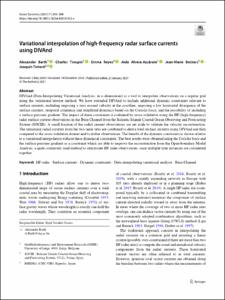| dc.contributor.author | Barth, Alexander | |
| dc.contributor.author | Troupin, Charles | |
| dc.contributor.author | Reyes, Emma | |
| dc.contributor.author | Alvera-Azcarate, Aida | |
| dc.contributor.author | Beckers, Jean-Marie | |
| dc.contributor.author | Tintore, Joaquın | |
| dc.coverage.spatial | Ibiza Channel | en_US |
| dc.date.accessioned | 2022-03-31T16:25:35Z | |
| dc.date.available | 2022-03-31T16:25:35Z | |
| dc.date.issued | 2021 | |
| dc.identifier.citation | Barth, A., Troupin, C., Reyes, E., et al. (2021) Variational interpolation of high-frequency radar surface currents using DIVAnd. Ocean Dynamics 71, pp.293–308. DOI: https://doi.org/10.1007/s10236-020-01432-x | en_US |
| dc.identifier.uri | https://repository.oceanbestpractices.org/handle/11329/1906 | |
| dc.description.abstract | DIVAnd (Data-Interpolating Variational Analysis, in n-dimensions) is a tool to interpolate observations on a regular grid
using the variational inverse method. We have extended DIVAnd to include additional dynamic constraints relevant to
surface currents, including imposing a zero normal velocity at the coastline, imposing a low horizontal divergence of the
surface currents, temporal coherence and simplified dynamics based on the Coriolis force, and the possibility of including
a surface pressure gradient. The impact of these constraints is evaluated by cross-validation using the HF (high-frequency)
radar surface current observations in the Ibiza Channel from the Balearic Islands Coastal Ocean Observing and Forecasting
System (SOCIB). A small fraction of the radial current observations are set aside to validate the velocity reconstruction.
The remaining radial currents from the two radar sites are combined to derive total surface currents using DIVAnd and then
compared to the cross-validation dataset and to drifter observations. The benefit of the dynamic constraints is shown relative
to a variational interpolation without these dynamical constraints. The best results were obtained using the Coriolis force and
the surface pressure gradient as a constraint which are able to improve the reconstruction from the Open-boundary Modal
Analysis, a quite commonly used method to interpolate HF radar observations, once multiple time instances are considered
together. | en_US |
| dc.language.iso | en | en_US |
| dc.rights | Attribution 4.0 International | * |
| dc.rights.uri | http://creativecommons.org/licenses/by/4.0/ | * |
| dc.subject.other | HF radar | en_US |
| dc.subject.other | Dynamic constraints | en_US |
| dc.subject.other | Data-interpolating variational analysis | en_US |
| dc.title | Variational interpolation of high-frequency radar surface currents using DIVAnd. | en_US |
| dc.type | Journal Contribution | en_US |
| dc.description.refereed | Refereed | en_US |
| dc.format.pagerange | pp.293–308 | en_US |
| dc.identifier.doi | https://doi.org/10.1007/s10236-020-01432-x | |
| dc.subject.parameterDiscipline | Currents | en_US |
| dc.subject.dmProcesses | Data analysis | en_US |
| dc.bibliographicCitation.title | Ocean Dynamics | en_US |
| dc.bibliographicCitation.volume | 71 | en_US |
| dc.description.sdg | 14.a | en_US |
| dc.description.eov | Surface currents | en_US |
| dc.description.adoption | Validated (tested by third parties) | en_US |
| dc.description.methodologyType | Method | en_US |
| dc.description.methodologyType | Reports with methodological relevance | en_US |
| obps.contact.contactname | Alexander Barth | |
| obps.contact.contactemail | A.Barth@ulg.ac.be | |
| obps.resourceurl.publisher | https://link.springer.com/article/10.1007/s10236-020-01432-x | |
 Repository of community practices in Ocean Research, Applications and Data/Information Management
Repository of community practices in Ocean Research, Applications and Data/Information Management

